Tag: plans
Getting work done in difficult times
Even during less stressful times, I sometimes have trouble concentrating on my work. I can spend too much time worrying about everything on my to-do list, or lose focus when I’m interrupted, and then at the end of the day I’m disappointed with my output.
Then at the beginning of March 2020, my day-to-day anxiety spiked with the news headlines and worries about family and friends, and my work productivity took another hit. I knew I needed to break away from habits that were getting in the way of my work and replace them with simple, sustainable actions that help me succeed.
Different things will work for different people, but I have my best days when I do these two things:
- Commit to focusing on one thing at a time.
- Plan for something enjoyable when the workday is over.
Commit to focusing on one thing at a time
It isn’t enough for me to vaguely know that this is a good idea. When I wake up in the morning, I set an intention to focus on the task at hand, whether it is a work or personal project. I remind myself not to multi-task and to bring my attention back to what’s right in front of me if my mind starts to wander.
We’ve all heard about how mindfulness and being present helps us stay centered and mentally healthy. But it is equally true that splitting attention between multiple tasks and thinking about things besides what is in the present is harmful to wellbeing.
I didn’t take this seriously until I had a string of terrible workdays. I had a hard time concentrating and felt scattered because my attention kept jumping from the file I was updating, to the pings I got on messenger, to the meeting reminders, to the phone calls, on and on and on. By the end of the day I hadn’t made enough progress on anything to feel a sense of accomplishment. Instead I felt drained and frustrated.
It can be tempting to just do “one little thing” while on a boring conference call, and we can tell ourselves these little tasks like typing an email, or updating a file are productive, but any gains in time saved are cancelled out by the hit it takes to our brain power. If I’m really having a hard time staying focused in a virtual meeting, I take notes about what is being discussed.
Plan for something enjoyable when the workday is over
This could be anything that sounds nice; it doesn’t have to be anything grand. This is helpful because it gives you something to look forward to all day. It makes any tedious work feel temporary.
A recent fun thing to look forward to after work was having happy hour on my balcony. It was the warmest, sunniest day we’ve had all year and I was excited to have a little more time in the fresh air. I had planned to wrap up my work by 4:30 PM and go outside, even though I knew that my client would probably contact me about an urgent issue.
Sure enough, when I was halfway through a glass of chardonnay, my phone buzzed with a request to talk. It was no big deal. We chatted for all of 3 minutes, and I spent another 20 minutes on my laptop, while sitting on my living room floor with my feet on the balcony next to my glass of wine. Then I got back to enjoying my evening. If I hadn’t planned for my happy hour, I probably would have sat at my desk waiting in case my client needed me and I would have missed out on great way to wind down my day.
Another day’s plan was less ambitious: I decided that after I finished work and dinner, I would play a game on my phone for as long as I wanted before bed. Today’s plan is to bake chocolate chip cookies.
If it seems counterintuitive to be more productive at work by planning to have fun afterwards, consider how you feel when you’re looking forward to a big event, like an exciting vacation. It is a mood booster, and being in a good mood is great for productivity.
It also makes the not-so-fun parts of the workday more tolerable when you know that they will end, and you will soon be doing something that makes you happy.
Making it a habit
There are other things that also help me with energy and focus, like getting outside for a daily walk, eating nutritious food and limiting the amount of time I spend reading the news or social media. But I just do these things, without needing to be quite so intentional about it.
It takes time to build habits. Until it becomes an automatic part of my lifestyle to stay in the moment instead of multi-tasking, and to give myself something to look forward to every day, I need to remind myself to do these things. Sticky notes on my desk, a daily calendar reminder – whatever it takes.
These are stressful, uncertain times, which isn’t ideal for productivity. And yet for the last few weeks I’ve ended each day satisfied with what I’ve accomplished. And now I’ve got to complete my to-do list, which I’m excited about. Because when I’m done…there will be freshly baked cookies. Can’t wait!
I want to quit my job…two years from now
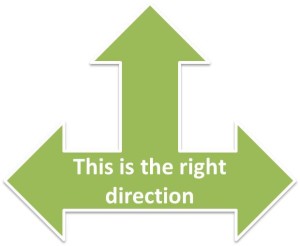 I’ve had a lot of conversations with people who tell me they want to quit their jobs, but not right now. They want to quit in two years. The most common reason is that people want to stop doing their current work and do something else…but they don’t know what that is. For some reason they think that in two years they will have figured that out.
I’ve had a lot of conversations with people who tell me they want to quit their jobs, but not right now. They want to quit in two years. The most common reason is that people want to stop doing their current work and do something else…but they don’t know what that is. For some reason they think that in two years they will have figured that out.
However, when you’re working a ton of hours in a stressful position, you don’t have much mental space or energy to determine what your next best job is. Plus, your free time is spent recovering or distracting yourself from your unhappy situation.
I feel your pain.
It wasn’t until I made up my mind that I was going to quit my job that I began to have ideas about what my future might look like. There was a definitive moment, a changing of my mindset, when I set my intention to quit. I turned my focus away from trying to make my current job situation better and focused on creating a better life. Like magic, I started getting inspired and followed my interests as far as they would go.
Here are a few examples of the actions I took and what they led to:
- After eight years without any creative writing, I started filling notebooks again. The ideas for stories, poems and lyrics popped into my head without even trying. I decided that after I quit my job I would spend a month at Naropa University’s Summer Writing Program. Once there, I wrote the outline for my self-help book for people who want to quit their jobs. I started this blog. I also kept writing creatively, joined writing groups, and volunteered with a literary magazine.
- I began researching and visiting animal sanctuaries. I documented their best practices and what they needed to improve. I have no idea if this will lead to any paid work in my future, but it was meaningful to me. The current outcome is that I have three favorite animal non-profits: Best Friends Animal Society, Chimpanzee Sanctuary Northwest and The Wild Animal Sanctuary.
- I realized that my love of research, analysis, report-writing and justice could lead to a career in private investigation. I got certified, built a marketing plan and decided this would be my next job. In case you haven’t been following my blog – I did not become a P.I. But planning to be a P.I. gave me the courage to quit my job and continue pursuing my interests until I ultimately began my consulting business.
Which leads me to this point: you don’t have to figure out your next job right now. All you have to do is follow your interests. Two years from now, your ideal job may be completely different – and better – than anything you can dream of now.
Happily, I’m not a data point of one. Many people who I spoke with followed a winding path to a satisfying career. If you need more convincing, read Martha Beck’s Finding Your Way in a Wild New World.
If you’re convinced but are thinking “what do I do now, I don’t even know what I’m interested in”, just experiment with one small, easy thing that you will enjoy doing. Make something with your hands. Revisit an old hobby. Do something you liked doing as a kid. Talk to a friend in a career that you may be interested in. Take a class or an evening workshop in a subject you are curious about. Read.
If you’re on the right track, more and more opportunities will open up to you, just as starting to write poetry again led to a month of writing classes and my book-in-progress.
When you’re not on the right track, you’ll lose interest or life will throw signs at you that it is time to change direction. For example, as I neared the date when I planned to quit my job, I began to doubt that a formal career in investigation was the right choice even though I enjoyed the process leading up to it. At the same time, a former coworker and I came up with a business idea and created an LLC in a blink. Several months later I realized our company wasn’t going to generate a salary and I moved onto my backup plan of consulting, which turned out to be a perfect career for me.
I didn’t cling to my initial idea out of stubbornness or misplaced determination. I was open to each new opportunity and was willing to move forward or change my plans as I went along. I like the metaphor of walking on a path with a lantern that only illuminates the step you’re at and where to place your feet next.
For example, if you are interested in making elaborate, one-of-a kind cakes, you don’t have to buy a bakery or launch a catering business. Have a friend or two commission desserts from you and if you enjoy it, do more. You might find that you only want to bake cakes for your loved one’s birthdays because it is a creative outlet and you feed off of their gratitude. Maybe you’ll realize you don’t want to make cakes for strangers, you don’t want to bake at all in the summer, and you really don’t want to produce a customer’s requested design if it isn’t a style you’re interested in.
When you pay attention, the universe will give you nudges in the right direction. What matters is that you are taking action. You are signaling that you are open to discovering a new path, one step at a time. If it leads you to another step forward– great! If you dislike it, or the choice generates negative results, then pursue your other interests.
If you’re one of those people who want to quit their jobs in two years, be clear about your intention. Then take one small action and you’re on your way.
Some Career Transitions Take Longer Than Others
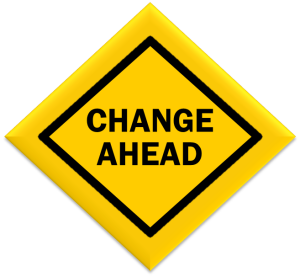 Some career transitions take longer than others. Leaving a project management role at one company for another may be a matter of updating your LinkedIn profile, and making connections with recruiters, and performing well in interviews.
Some career transitions take longer than others. Leaving a project management role at one company for another may be a matter of updating your LinkedIn profile, and making connections with recruiters, and performing well in interviews.
Wholesale career changes might take longer. Not much longer if you’ve got transferable skills, are allied with an influential person at the place you want to work, launch your own enterprise or are just plain lucky.
It takes longer if your new career path requires going back to school for training or degrees, or means taking an entry-level job to gain experience in an unfamiliar field. But time is relative and two or three years of learning the ropes at a low-paying, low-stress, starter position might be the perfect transition between a job you hated and a new career that you’ll love for the rest of your working years.
I worked with a guy who transitioned from a six-figure sales job into a lower paid marketing role to build a career with more opportunities. He is savvy and worked hard, and six years later I bet he’s earning more than he did in sales and enjoying his life much better. Another friend moved from a lucrative engineering role to finance because it gives him the experience and credibility he needs for his next career move.
If you dream of a different career but are afraid that it will take too long or cost too much to get there, remember that you can start building the skills you need right now, before you quit. Take a night class. Volunteer in a related field. Go to events focused on your career topic and network. Ask people already in the roles you want to give you thirty minutes for an informational interview, where you ask them what skills and experience are needed to get started, what they actually do each day, and whether they like it or not.
I’ve done all of these things with great results. A series of informational interviews was how I learned early in my career that I wanted to focus on business, marketing and writing, and not on graphic design. I earned my MBA in five years of evening classes, and went to work each morning applying the knowledge I had just learned. I went to conferences and exchanged dozens of business cards with recruiters, executives and friendly people who I connected with. I’m still in touch with many of them.
If you’re still not convinced, read Jennifer Lesher’s blog post from May 20th, where she describes the transition from tech to airplanes. Can you feel her joy? Imagine yourself feeling the same way.
One More Thing Before I Quit
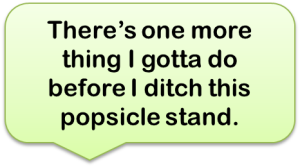 When you’re planning to leave your job, there’s one more thing you may want to add to your checklist.
When you’re planning to leave your job, there’s one more thing you may want to add to your checklist.
Besides saving extra money, planning for your future healthcare, making sure you leave with all the compensation you’re entitled to, and all the other tasks like getting your personal data off of your company’s computer, writing a positive goodbye email, and so on, there’s one more thing.
But only you know what it is.
Whether you’re unhappy in your current job, or just ready to move on, there’s probably something you want to accomplish before you’re done there. It could be finally learning a new skill that you had been avoiding or completing a project that gives you credibility for your next role. It could be finishing a program or product that you’ve been immersed in, and want to see through to the end.
Maybe you’re finally ready to apologize to a colleague to resolve a mistake you made in the past. It could be standing up to a workplace bully to prove to yourself that you won’t accept that kind of behavior. Or, establishing boundaries with your manager to reclaim your sense of personal power.
You know what it is. Add it to your list. Go do it.
Why I’m Not Planning For The Year Ahead and Using My Three Best Productivity Tips Instead
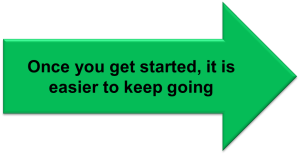 Each December and January I receive dozens of emails from productivity experts, and coaches and authors who write books about how to achieve your goals. They each recommend a system for setting goals for the new year ahead.
Each December and January I receive dozens of emails from productivity experts, and coaches and authors who write books about how to achieve your goals. They each recommend a system for setting goals for the new year ahead.
Last year I sifted through these choices and decided to use a comprehensive Word document planner. As I wrote my answers to the questions provided, I listed the focus areas of my life, my values, what I care about, how I want to feel and the skills I enjoy using. Then I made a table in my word document and listed my goals in the first column. Then I matched each of the other areas that I’d identified (values, what I care about, etc) with that particular goal.
Then I identified how I use each hour of the day vs. how I want to use each hour of the day, how I will work towards achieving my goals in each month of the year, and on and on. The entire document was eight pages. I was very serious about it, and it took me three days to complete it.
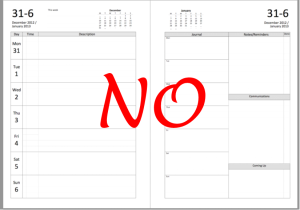 And then I never looked at it again until I opened the file to start writing this blog post.
And then I never looked at it again until I opened the file to start writing this blog post.
Almost immediately after I completed the planning document, I regretted that I wasted three days planning out my year instead of getting to work on the projects that I already know are most important to me. I didn’t need to list them on paper.
As I look back at the year that has past, that planning document didn’t help me at all.
Most of my goals turned out just fine. I launched my consulting company and am happy with the results of my first year in business. I took care of my health and my relationships. I launched my blog.
However my biggest goal was also my greatest challenge throughout the year: editing my book and preparing it for publication. The challenges are that it takes intense focus, a block of time to get my head into the work, energy and alertness, and what is often the toughest part: making my way to my office chair to open the document and get to work. Although I worked on it throughout the year, I’m frustrated that I still don’t have an agent-ready manuscript.
This year I am not filling out any annual planning worksheets or setting goals beyond using the best techniques that helped me move my book forward.
In order of the success I had with them, my tips for achieving goals are:
- Creating the smallest habit possible and then committing to repeating it every single day no matter what. For me, this was opening my word document and editing one sentence every day. Making the commitment was enough, but I sometimes used “The Chain Habit”, where you mark on a calendar each day that you complete your goal.
- Allowing other people to push you forward. This isn’t always pleasant. It can feel a little like bullying. But nudges from other people got me to reach out to the one editor that I wanted to work with. She accepted my project and I was thrilled with her edits and suggestions.
- Using self-talk to motivate yourself. Most of us learned in science class that a body in motion is likely to stay in motion and a body at rest is likely to stay at rest. So when I feel inertia, I tell myself that I just have to get started by opening my word doc. Once I get started, everything will be easier.
Whether you enjoy creating detailed plans for the year ahead or reject the whole concept, I wish you the best of luck in achieving your goals this year.
Why it’s Smart to be Prepared to Leave Your Job on a Moment’s Notice
Whether you plan to quit your job now or never, it is smart to be ready to leave on a moment’s notice. It’s not about being fearful that you might lose your job. It’s about gaining confidence by being prepared.
Here’s why it’s important:
- Being ready to quit is like having a grab-and-go bag for your career. Tomorrow might be your last day at work whether you want it to be or not. Layoffs happen, businesses fail, companies relocate. Job security is more of a wish than a reality.
- You’ll be empowered. You’ll have options and will be less dependent on your employer to meet your financial needs and your personal career goals.
- You may be more successful at your job. Feeling that you can leave at any time, you might take smart risks that pay off. You might speak up more, and get more attention for your projects.
- You’ll be more agile. If you’re shoulder-tapped to transfer to a new role or new location, you can change gears quickly. Or you can say no and let the chips fall where they may, because you’re ready for it.
There are multiple components to being fully prepared that involve finances, health, shoring up support and more. If you don’t know where to start, take a look at your work tools. If you’re using a computer or cell phone provided by your employer, would you be ok if you were asked to hand them over tomorrow? If not, wipe all your personal photos, documents and data from your employer’s property. Stop using your company’s email address for personal communications. Make sure you have copies of your address book on your own computer and phone.
Another step is to make sure you’ve got copies of important information safely stored at home. This includes copies of your performance reviews and records of awards and achievements, so you can use that information to customize resumes in the future. It also includes having a portfolio of work samples that you can use in future interviews or as resources in your next role. Work samples could be snapshots of projects you worked on, non-confidential reports and presentations, or tangible materials that you produced. Make sure to take home financial documents like recent pay stubs and information about company-sponsored retirement plans and investments.
A third place to consider is your work space. Years ago my office was draped in personal belongings. I had two lamps, framed art on the walls, and a bookcase full of books, awards and photos. I even had hippie beads hanging from my door frame. (Don’t judge – people loved my office!) But when I left my office for the last time, I walked out with a single cardboard box of personal items. As I was working through my exit plan, I slowly swapped out the objects that were most important to me with fewer and more portable pieces. If you make this transition thoughtfully, nobody else will notice. But you’ll have the satisfaction of knowing you could hold your cardboard box in one hand while you use the other to wave ‘bye.
How to Get Stuff Done When You’re Working For Yourself
I’m a productive person. I like to get stuff done. I’m not new to this. I make lists, I use Outlook to schedule my days and my tasks. I have a spreadsheet of running projects and detailed steps to complete them.
But now it’s 5:14PM, I’ve got to leave for yoga at 5:30PM and where did the day go? I did my day-job stuff. I emailed the landscaper to follow up on a quote. I updated expense information for my startup business. I sent three personal emails. So it’s not like I wasted the day. But crap. I’m staring down a weekly to-do list full of tasks that I haven’t done yet, including making progress on my two most important goals: revising my manuscript and updating my blog. Staring at a list full of things to do that are not checked off feels like staring the in the face of futility.
I’m irritated with this day.
I did not get up early to work on editing my book and I didn’t work on it during lunch. I just…ate lunch. OK it’s after work and I’m writing this blog post. But now it’s 5:17PM and I have 13 minutes until I need to be in the car, on my way to yoga.
This isn’t working.
I didn’t want working on my book or blog to feel like pressure or a chore, or something negative that I dreaded. Nobody is forcing me to do these things. My deadlines are made-up.
That’s the problem. I’m really good at meeting deadlines imposed by structures outside of myself. Whenever I’ve taken classes, I’ve always done my homework and turned in my assignments on time. I pride myself on always hitting my work deadlines.
But when it is my own deadline, it’s much easier to blow off.
5:27PM. Got to go. Dammit. Just when I was getting somewhere with this blog post.
May 1st, 2014, 6:28AM
Milo kept walking on me and making noise so I got up. I wanted to be up before 7AM anyway to work on my book and this blog post before I start my day job. So now I’m up and my eyes are barely focusing. Is this how it has to be? In order to make progress on my writing I have to be pushed into it?
When I was working my corporate job and running on adrenaline I got a ton of stuff done. I was always going, rushing, doing. Since I’ve unplugged from that machine, I’m on a slower pace. I’m still efficient with specific projects, but I don’t get as much done in a day. Transitions take longer.
I’ve been emailing a friend about this topic and he sent me a link to this article about Jerry Seinfeld’s Chain Habit. The idea is to put an X on a calendar for every day you work on your goal. When you see the lines of X’s, you don’t want to break the chain.
It’s like when we were kids and we got a little star sticker for each day that we did whatever task we were supposed to do. Except that back then, it didn’t motivate me. I felt manipulated and the reward of a sticker wasn’t stronger than my drive for autonomy.
But now I’m only struggling against telling myself what to do, and making a daily commitment worked for me in the past. When I finally got my first draft written for my book, it was because I committed to opening my word doc every single day and writing one sentence. Even on Thanksgiving and Christmas Day when I was at my parents’ house, I had my PC with me. Of course once I had the word doc open I wrote a lot more than one sentence.
I’ve been frustrated with how little I’ve done to revise my book, and think the solution is the same one that I did with the first draft – to commit to opening the word doc and revising one sentence every day. I kept deluding myself that I need larger chunks of time to get my head into editing mode, but I haven’t been using the big blocks of time that I do have so it’s time to try something else.
There’s got to be a way of making significant progress without resorting to becoming addicted to the process. Or maybe there isn’t. Because the Chain Habit or committing to writing every day no matter what feels like an addiction as much as a habit.
Maybe the difference is limiting the time spent. Maybe it is healthy enough to be addicted to writing a bit every day if I also do my day job well and keep enough time in my day for the other things I want to do plus a certain amount of unstructured time each week.
I emailed my friend about this and he wrote back musing about the difference between addiction and habits. I found an article on the topic that says habits can be good or bad and we have control over them. Addiction is negative and compulsive.
When I was in the habit of writing for my book every day, it felt good to make daily progress. Most of the time I wrote in the morning and started the day feeling good about working toward my goal. The times when it was late at night and I was tired and didn’t want to open my computer, I felt a sense of panic and did it anyway. I felt a compulsion. I did the work even when I didn’t want to, even when it was difficult to get to my PC, because I didn’t want to feel disappointed in myself for not doing it.
I wish I d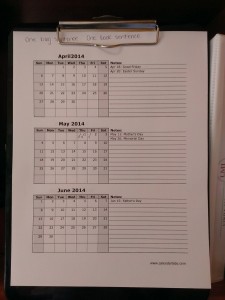 idn’t have to pressure myself or create a situation where I feel afraid and dread if I don’t work on my writing. But at this point, the desire to achieve my writing goals is bigger than the desire to avoid bullying myself into doing the work.
idn’t have to pressure myself or create a situation where I feel afraid and dread if I don’t work on my writing. But at this point, the desire to achieve my writing goals is bigger than the desire to avoid bullying myself into doing the work.
I also hate being tied to my PC, but my PC is where my work happens. If I know I’m going to be away from my PC, I could save my files on OneDrive and at least go through the motion of opening the docs on my phone and writing. I could also write a blog post long-hand in my notebook and transcribe it later, and do the same with my book revisions, but it isn’t as effective as typing into my word doc. They aren’t perfect solutions but I guess I’d rather use these contingencies than “break the chain”. I’d rather have these backup plans in place than not set my goal in the first place.
May 2, 2014, 7:38AM
I got up at 6:30AM again today, and went right to my PC to work on this blog post. It’s day two of my new chain habit, and I can already X-off this goal. There’s still a little time to open my book document and revise at least one sentence today.
Then I’ll make a cup of tea and raise a toast to myself: here’s to my new addiction.
Sometimes The Outline Happens Last
I have been frustrated that I’m not making as much progress on my book as I wanted to. I finished the first draft in December and my goal was to revise it to the point where I could hand it off to a professional editor by the end of February. But it’s halfway through March and there’s a ton of rework to do before it’s ready for editing.
The biggest challenge I’ve had with the revision process is that the document hasn’t been well-organized. This book was born from a four-page outline that I wrote as a class assignment last July at the Jack Kerouac School. The outline describes what happens when people want to quit their jobs but feel stuck, talks about how to break through those barriers, and goes on to offer a plan for making an exit.
I still like that outline! But when I started writing the actual content I thought I needed to simplify it to three sections about timing, money and how to set yourself up for a positive experience after you’ve left your job. That format was easier for me to describe to people and seemed like a good container to fill. But I pretty quickly got into a bind when I wanted to write about topics that didn’t fit into either one of the outlines. At that point I was stuck for weeks and the only writing that happened was poetry and journaling.
Finally I gave myself permission to write whatever the hell I wanted to for my book. I had a running list of topics that I logged in a spreadsheet. When I sat down at my PC to write, I would either look at the list or just write whatever I felt like writing. I would open my word document, create a bold header for whatever the topic was about, and get to it.
On December 30th, the day that I finished my rough draft, I had an idea for a third outline based on steps that people could take to quit their jobs comfortably. I was thrilled with this last-minute inspiration because it sounded like something agents and publishers would go for. You know, “the seven steps to quit like a winner”. It has a great ring to it, don’t you think?
However, the more I reflected on it over the following weeks, I wasn’t sure those seven steps were really necessary, and there were topics I cared about that didn’t line up with this version of an outline either.
The problem I created for myself by adding section after section into my word document based on whatever I felt like writing each day was that there was no logical order. My draft was 100 pages of single spaced text and scrolling through page after page to find sections that seemed like they would fit together in chapters wasn’t working very well.
I thought that printing out the manuscript would help. I made a copy and started going through it with a red pen. But I sensed it was a wasted effort because I couldn’t see how the pieces connected to each other or the book as a whole.
I’d heard of authors spreading their manuscript pages on the floor and then walking around, sorting them. Maybe they have bigger living rooms than I do? I got about 50 pages down on the carpet before I ran out of room.
And there wasn’t enough space left for me to walk around and rearrange the papers, so I ended up walking on the paper, which made me feel like I was insulting myself. Milo, my cat, was confused at first and then he started walking on the papers, too. Cats are always happy to insult people.
Then I thought maybe it would be better if I got a pad of Post-its that I could write editing comments on and stick to the papers. Like, “move this section to the introduction.” I made a few notes, stuck them on the papers, and then Milo wanted to go out on the deck and a big gust of wind blew the papers all over. Enough of that.
But the notes gave me an idea. I wrote the different topics of the book on individual Post-its and saw patterns emerge. Before long I grouped each topic that I had written about into chapters, and moved the chapters into a logical order. They are now tidily laid out on my dining room table.
A bunch of pink Post-its might not seem like a big deal, but it is a big step towards making my book a reality. Now I can go back through the printed manuscript and re-order the pages to match the chapters, and then make revisions knowing how each topic flows into the next.
It would have been a much easier process if I could have written the book in order all the way from the introduction to the afterward. I love plans – planning is smart, saves time and helps get results. But that’s not how it went. Sometimes the outline happens last.

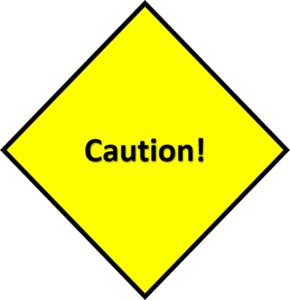

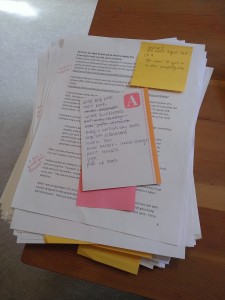
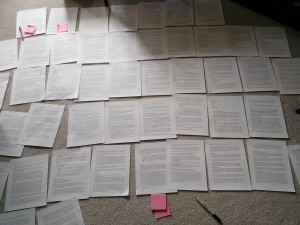

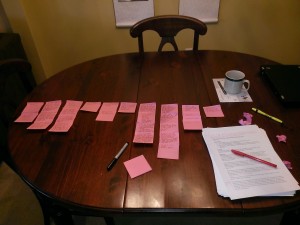
Recent Comments